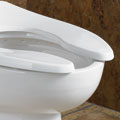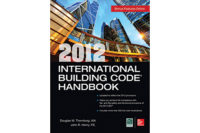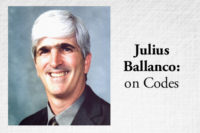
A proposal to double the number of water closets in small restaurants was denied.
It is hard to believe the 2012 International Plumbing Code (IPC) was finalized this past May. But based on the new schedule used by the International Codes Council, the Plumbing, Mechanical and Fuel Gas codes were completed with the final code-change hearing in Dallas.
The economy definitely took its toll on the code-change process. The crowd present in Dallas was smaller than normal, but that doesn’t mean there weren’t lively discussions on many of the issues.
Single-Stack Venting
Many of the changes that were approved will impact the plumbing and mechanical engineering community. Most of the ASPE code changes were accepted. Single-stack venting, also known as Philadelphia single stack, was added to Chapter 9. This was a major change that has long been supported by ASPE.While the Uniform Plumbing Code and National Standard Plumbing Code added single-stack venting to their codes, both codes include the requirements in the appendix on engineered design. The IPC added the requirements to the body of the code without having to classify the system as an engineered design.
Siphonic Roof Drainage
Another major change was the addition of siphonic roof drainage to Chapter 11. This was a change put forth by ASPE, with reference to ASPE 45, the design standard for siphonic roof drainage. Siphonic roof drainage will now become an option for a roof storm-drainage system.It is anticipated that, with the change in the IPC, siphonic roof drainage will begin to take off in popularity. Currently, very few buildings are designed with a siphonic roof-drainage system. The system requires more extensive engineering. However, there are smaller piping networks and it is considered green. With an air break at the base of the piping network, rainwater harvesting also becomes easier.
The Air And Water Show
The use of air admittance valves in special waste systems was approved. The air admittance valve must be listed for the chemical waste anticipated in the drainage system. This will make venting island lab sinks much easier.A change that was not approved would have affected the protective coverings for traps and water riser tubes on accessible lavatories. The proposal would have required the protective coverings to have a flame spread of 25 or less and a smoke developed rating of 450 or less.
Potty Parity
Once again, there was a lot of discussion on the number of fixtures and potty parity. There was an attempt to double the number of water closets in a small restaurant. During the testimony, it was pointed out that doubling the number of water closets doesn’t just double the space required, it nearly quadruples the space.Rather than having a single-occupant toilet room, you would have to build an accessible toilet room with two water-closet compartments.
The testimony also indicated there were no studies to show that the number of water closets was inadequate. The comments by those in favor discussed the time required to use a fixture. Those opposed pointed out the number of fixtures is based on the wait period, not the use period. The code change to double the fixtures in small restaurants and bars was denied.
A code change proposed to add potty parity to business buildings was proposed. The testimony centered on women’s need for more time. While those in opposition all supported potty parity, they argued the data does not support the offsetting of numbers for business occupancies. The code change was denied.
Hot-Water Happenings
Another change was submitted to require a pan only when tank-type water heaters are located in areas where a leak would cause structural damage to the building. Opponents wanted the requirement to apply to tankless water heaters as well. The change was approved to apply only to tank-type water heaters.Other hot-water issues related to the distance required before hot water recirculation was required. The current code requires the hot water supply system to have the temperature maintained when the distance from the water heater to the farthest fixture exceeds 100 feet. A change was proposed to lower this distance to 50 feet.
A public comment to the 50-foot requirement would have added requirements to the branches off the main hot water line that had the recirculation. The change would have stipulated the amount of water that could be discharged before hot water was received at the fixture. The public comment was not accepted. However, the change to lower the distance to 50 feet was approved.
Indirect Waste
The modification to the drain requirements for commercial kitchens will have an impact on the design of a commercial kitchen. The code currently permits dishwashing sinks to discharge either indirectly or directly to the drainage system. These fixtures, commonly referred to as pot sinks, have long been permitted to connect directly to the drainage system with the reason being there is no food preparation in the sink, therefore a backup will not contaminate any food that may be consumed.The opposing view was that the sink poses a hazard of contamination to the pots, pans and utensils used to prepare food. Therefore, an indirect waste is necessary. The code change to mandate an indirect waste for these connections was approved.
Graywater Provisions
ICC saved one of the biggest changes for the end of the hearings. There was a proposal to move the graywater provisions from the appendix to a new Chapter 13 in the body of the code. The Code Change Committee had recommended denial of the change citing the need to improve the code requirements.The discussion centered on the need to have green provisions in the body of the code and the concern for using nonpotable water inside the building. Those opposed to the change raised very good points about systems that are not properly maintained. This was countered by identifying the need to maintain any plumbing system, not just graywater systems. The code change was approved for inclusion in the code.
This completes the code change cycle for the 2012 code. ICC announced the 2012 International Plumbing Code will be available in the early part of 2011.



